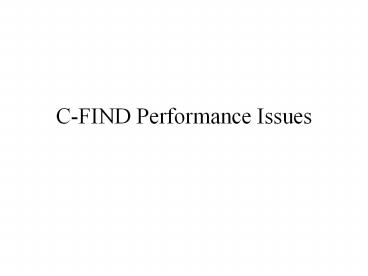C-FIND Performance Issues - PowerPoint PPT Presentation
Title:
C-FIND Performance Issues
Description:
The major performance advantage is that this does not require any access to the ... explosion occurs when there are several multi-valued attribute queries. ... – PowerPoint PPT presentation
Number of Views:16
Avg rating:3.0/5.0
Title: C-FIND Performance Issues
1
C-FIND Performance Issues
2
Multiple Patient IDs
- PACS increasingly have records transferred
between facilities (IHE and otherwise) - Transferred patient records have different
Patient IDs (issued by the original facility) in
many cases. - Typical real patient queries now often require
3-10 distinct separate patient level queries. - MPI, IHE PIX/PDQ, etc deal with obtaining the
list of patient IDs related to the real world
patient. - PACS query overhead is a problem.
3
Multi-ID Overhead
- Two sources of overhead penalties
- Failure to implement multiple asynchronous
requests for C-FIND. - Cannot overlap queries
- Do not overlap/stream C-FIND responses
- Less efficient query processing
- Most index systems can handle a query for a short
list of IDs faster than a list of individual
queries.
4
Multi-ID magnitude
- There is a 2-3 fold increase in query volume
compared with Y2k, due to rapidly increasing
sharing of patient data. - There are now thousands of workstations issuing
queries to the PACS archive.
5
Large Query Responses
- For a large series (e.g., spiral CT), MWL, etc.
there are often very large responses. These have
problems - (Small) each response must be in a separate
P-DATA response. This incurs P-DATA and PDV
overhead. - (Large) the responses cannot be compressed. For
a spiral CT with 1,000 slices and a query with a
significant list of return keys, this is a lot of
data. It would compress very well with GZIP. - (Variable) The many individual P-DATA transfers
often interact very badly with high latency TCP
links.
6
Compression Fix
- Simply adding G-ZIP on a per P-DATA basis does
not provide much improvement. - Adding G-ZIP compression on a stream basis
introduces problems for cancellation, but
achieves very high compression for highly
redundant responses like those for a spiral CT. - Sample implementation
- Collect P-DATA responses, compress them, and
send. The last few bytes will not be sent until
the next P-DATA. The last few bytes of the last
response will not be sent until the P-DATA for
complete.
7
Query volume increases
- Number of active workstations has increased, and
now reaches thousands per PACS archive. - Number of SOP instances has increased from
hundreds per patient to many thousands per
patient. - Multi-frame new objects will help slow the growth
as old CT/MR/ are replaced. - New kinds of objects for new imaging purposes
continues to increase the objects per query
response.
8
Large queries
- This is similar to the no pixel data transfer
syntax, but only sends the implemented return
keys. - The current system for C-FIND requires the SCU to
list every possible interesting index attribute.
This list can be very large. - A much smaller query would be for all
implemented return keys. - The major performance advantage is that this does
not require any access to the bulk data storage.
It only needs to access the database keys.
9
Large Query volume
- As MWL, Hanging Protocol, and other query
intensive SOPs gain use, this volume is
increasing. - The query based data retrieval for any SOP with
extensible return keys results in large queries
and configuration work to include the complete
list of potential return keys in every query.
10
Multi-valued queries
- Increasingly queries involve matching a list of
attribute values. Patient ID is just one
example. Another is a search for matching
foot, ankle, or toe in a search. Another
is a MWL query for machine rooms A, B, and C. - Present C-FIND requires multiple independent
queries. - Cross-product explosion occurs when there are
several multi-valued attribute queries. - DBMS systems are designed to handle problems like
this. - The only current DICOM option is to ship all the
candidate object indices to the SCU and have the
SCU manage the cross product.
11
Multi-valued Queries
- The network DBMS standards do not provide a good
solution. - Network SQL cross vendor interoperability is
poor. - Network SQL cross application interoperability is
poor. - XSLT, XPATH, and related technologies are being
used, but again with poor cross application
interoperability. - It may be beyond the state of the art to reach a
general solution, but some modest extensions to
add limited range/ list to DICOM query might
reduce the query volume sufficiently.

